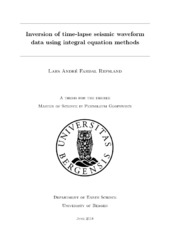| dc.contributor.author | Refsland, Lars André Fardal | |
| dc.date.accessioned | 2018-08-16T14:29:42Z | |
| dc.date.available | 2018-08-16T14:29:42Z | |
| dc.date.issued | 2018-06-20 | |
| dc.date.submitted | 2018-06-19T22:00:14Z | |
| dc.identifier.uri | https://hdl.handle.net/1956/18123 | |
| dc.description.abstract | Time-lapse seismic data are considered a valuable tool for monitoring hydrocarbon reservoirs. Since the changes in elastic parameters associated with production of hydrocarbons, or injection of CO2 into a reservoir, tend to be relatively small compared to that of the geological surroundings, scattering integral equation methods have been chosen for the task of modelling time-lapse seismic data. Full waveform inversion (FWI) is a comprehensive imaging technique that employs all of the information contained in seismic data, including travel times, amplitudes, internal multiples and diffractions. This was first performed using the distorted Born iterative T-matrix (DBIT) method, an iterative inversion approach that solved linear inverse problems at every iteration. This method has been performed on two models. Two time-lapse experiments was performed using a sequential strategy. First a time-lapse effect was reconstructed on a simple 2D reservoir model. This was followed by a demonstration of the time-lapse inversion of a re-sampled version of the Marmousi model. For future applications in ensemble based history matching, a linear Bayesian approach, using the distorted Born approximation, has been examined. The inversion process was linearised around a reconstructed inhomogeneous baseline model, for which Green's functions were calculated. The distorted Born approximation was then used with explicit Bayesian expressions, resulting in a maximum a posteriori (MAP) solution of time-lapse effect. Posterior uncertainties were also obtained. The Bayesian inversion method has been tested in two different time-lapse scenarios. First the Marmousi model was introduced with a relatively large time-lapse velocity change. The linear Bayesian time-lapse inversion was also tested on a smaller contrast. The DBIT method did prove to be able to reconstruct both models to a satisfying degree. The linear Bayesian time-lapse inversion was also able to reconstruct a time-lapse effect in the Marmousi model, even with a high level of noise. | en_US |
| dc.language.iso | eng | eng |
| dc.publisher | The University of Bergen | en_US |
| dc.subject | full waveform inversion | eng |
| dc.subject | time-lapse | eng |
| dc.subject | Seismic waveform modelling | eng |
| dc.subject | Bayesian inversion | eng |
| dc.subject | Seismisk oljeleting | nob |
| dc.subject | Seismiske bølger | nob |
| dc.subject | Seismiske data | nob |
| dc.title | Inversion of time-lapse seismic waveform data using integral equation methods | en_US |
| dc.type | Master thesis | |
| dc.date.updated | 2018-06-19T22:00:14Z | |
| dc.rights.holder | Copyright the Author. All rights reserved | en_US |
| dc.description.degree | Masteroppgave i geovitenskap | en_US |
| dc.description.localcode | MAMN-GEOV | |
| dc.description.localcode | GEOV399 | |
| dc.subject.realfagstermer | https://data.ub.uio.no/realfagstermer/c000962 | |
| dc.subject.realfagstermer | https://data.ub.uio.no/realfagstermer/c006706 | |
| dc.subject.realfagstermer | https://data.ub.uio.no/realfagstermer/c000454 | |
| dc.subject.nus | 756199 | eng |
| fs.subjectcode | GEOV399 | |
| fs.unitcode | 12-50-0 | |
